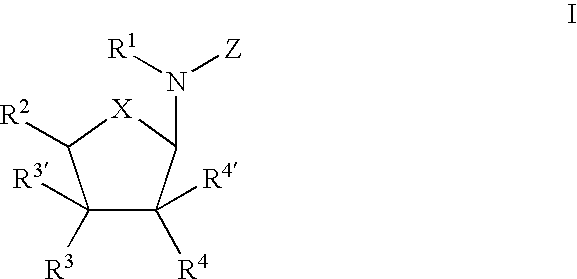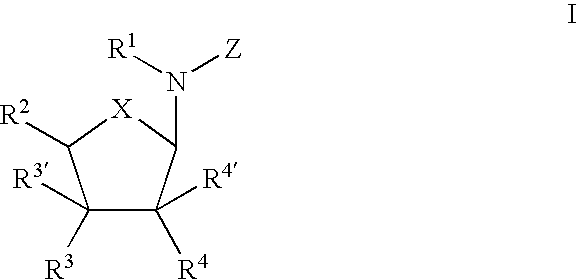Use of nucleoside compounds for nonsense suppression and the treatment of genetic diseases
a nucleoside compound and nonsense suppression technology, applied in the field of nucleoside compounds, can solve the problems of many amino acid substitutions that do not have a gross effect on protein structure or function, major disruption of the genome, and can produce aberrant proteins in cells, so as to minimize the spread or worsening of diseases.
- Summary
- Abstract
- Description
- Claims
- Application Information
AI Technical Summary
Benefits of technology
Problems solved by technology
Method used
Image
Examples
example 3
5.3 Example 3
100 mg Oral Dosage Form
[0361]Table 3 illustrates a batch formulation and a single dose unit formulation containing 100 mg of clitocine.
[0362]
TABLE 3Formulation for 100 mg tabletPercentQuantityQuantityMaterialby Weight(mg / tablet)(kg / batch)6-Amino-5-nitro-4-(β-D- 40%100.0020.00ribo-furanosylamino)pyrimidine (Clitocine)Microcrystalline Cellulose,53.5% 133.7526.75NFPluronic F-68 Surfactant4.0%10.002.00Croscarmellose Sodium Type2.0%5.001.00A, NFMagnesium Stearate, NF0.5%1.250.25Total100.0% 250.00 mg50.00 kg
[0363]The microcrystalline cellulose, croscarmellose sodium, and clitocine are passed through a #30 mesh screen (about 430μ to about 655μ). The Pluronic F-68® (manufactured by JRH Biosciences, Inc. of Lenexa, Kans.) surfactant is passed through a #20 mesh screen (about 457μ to about 1041μ). The Pluronic F-689 surfactant and 0.5 kgs of croscarmellose sodium are loaded into a 16 qt. twin shell tumble blender and are mixed for about 5 minutes. The mix is then transferred to ...
example 4
5.4 Example 4
[0364]A concentrate is prepared by combining clitocine and a 12.6 kg portion of the trichloromonofluoromethane in a sealed stainless steel vessel equipped with a high shear mixer. Mixing is carried out for about 20 minutes. The bulk suspension is then prepared in the sealed vessel by combining the concentrate with the balance of the propellants in a bulk product tank that is temperature controlled to 21° to 27° C. and pressure controlled to 2.8 to 4.0 BAR. 17 ml aerosol containers which have a metered valve which is designed to provide 100 inhalations of the composition of the invention. Each container is provided with the following:
[0365]
ipratropium bromide, 6-Amino-5-nitro-4-0.0021 g(β-D-ribofuranosylamino)pyrimidinetetrahydro-furan-3,4-diol0.0120 gtrichloromonofluoromethane1.6939 gdichlorodifluoromethane3.7028 gdichlorotetrafluoroethane1.5766 gtotal7.0000 g
example 5
5.5 Example 5
Intravenous Dosage Form
[0366]The intravenous formulation is prepared by reconstituting clitocine with an appropriate liquid medium, such as water for injection (WFI) or a 5% dextrose solution. A desired concentration of the intravenous formulation can be obtained by reconstituting an appropriate amount of clitocine with an appropriate volume of liquid medium. A desired concentration of the intravenous formulation provides a therapeutically effective amount of clitocine to the patient, preferably a mammal, more preferably a human, in need of the intravenous pharmaceutical formulation and maintains a therapeutically effective level of clitocine in the patient. The dose which is therapeutically effective will depend on the rate at which the intravenous formulation is delivered to the patient and the concentration of the intravenous formulation. For example, two vials containing a composition (e.g., 500 mg of clitocine per vial) are reconstituted with a 5% dextrose solution...
PUM
| Property | Measurement | Unit |
|---|---|---|
| weight percent | aaaaa | aaaaa |
| weight percent | aaaaa | aaaaa |
| weight percent | aaaaa | aaaaa |
Abstract
Description
Claims
Application Information
 Login to View More
Login to View More - R&D
- Intellectual Property
- Life Sciences
- Materials
- Tech Scout
- Unparalleled Data Quality
- Higher Quality Content
- 60% Fewer Hallucinations
Browse by: Latest US Patents, China's latest patents, Technical Efficacy Thesaurus, Application Domain, Technology Topic, Popular Technical Reports.
© 2025 PatSnap. All rights reserved.Legal|Privacy policy|Modern Slavery Act Transparency Statement|Sitemap|About US| Contact US: help@patsnap.com



